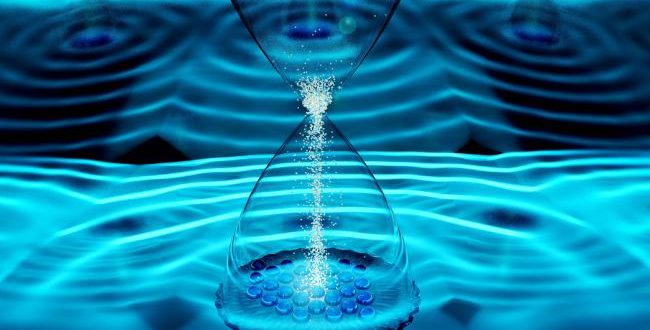A team of scientists led by physicists at the University of Maryland-based Joint Quantum Institute (JQI) have created the world’s first time crystal using a chain of atomic ions.
Crystals such as ice or diamond are made of atoms arranged in a repeating pattern in space. These new time crystals have atoms follow a repeating pattern, but in time rather than space. The UMD-led team’s creation brings to life the exotic idea that it might be possible to create such time crystals that was proposed in 2012 by Nobel-prize winning MIT physicist Frank Wilczek.
Much like freezing destroys the symmetry of liquid water, a time crystal disturbs a regularity in time. This is somewhat surprising, says lead author and JQI/ UMD postdoctoral researcher Jiehang Zhang, since nature usually responds in sync to things that change in time. “The earth rotates around the sun once a year, and the seasons have the same period,” Zhang says. “That’s what you would naturally expect.”
A time crystal doesn’t follow this expectation, instead responding with a slower frequency—like a bell struck once a second that rings every other second. The atomic ions in the Maryland experiment, which researchers manipulated using laser pulses, responded exactly half as fast as the sequence of pulses that drove them. Their results are reported in the March 9 issue of the journal Nature.
Zhang, Christopher Monroe, a UMD Distinguished University Professor of Physics and a JQI Fellow, and a group of experimentalists at UMD teamed up with a theory group at the University of California, Berkeley to create their time crystal. The Berkeley group, led by physicist Norman Yao, had previously proposed a way to create time crystals in the lab. For a chain of atomic ions, the challenge came down to finding the right sequence of laser pulses, along with assembling the sea of mirrors and lenses that ensured the lasers impinged on the ions in the right way.
To create their time crystal, researchers activated three types of laser-driven behavior in a chain of ten ytterbium ions. First, each ion was bombarded with its own individual laser beam, flipping an internal quantum property called spin by roughly 180 degrees with each pulse. Second, the ions were induced to interact with each other, coupling their internal spins together like two neighboring magnets. Finally, random disorder—essentially noise—was sprinkled onto each ion, a feature known from previous experiments to prevent the spins from jostling and heating up the chain.
Altogether, this sequence twisted around the ions’ spins, and researchers kept track of the orientation of each spin after many repetitions of the sequence. When all three laser-driven behaviors were turned on, the spins of each ion synced up, and they would rhythmically return to their original direction at half the speed of the laser sequence.
But a time crystal is more than mere repetition, and this alone would not be enough to claim the creation of a time crystal, Zhang says. A crystal also needs to be rigid. “If you put a bunch of billiard balls on a pool table separated by exactly 10 centimeters, is that a crystal?” Zhang says. “Not really, because if you shake the table a little bit it will fall apart.”
Zhang and his colleagues demonstrated that their ions had this rigidity by attempting to artificially “melt” the time crystal. By modifying one of the laser pulses—essentially shaking the table—they observed that the rhythm remained stable, up to a point. Past a certain amount of heating, the time crystal dissolved away, just as an ice cube can melt back into a small puddle of water. But with weak shaking, it remained stable, a fact that provided the key evidence that they had created a time crystal.
This rigidity makes time crystals a potential ingredient for clocking complex quantum systems that have inherent defects and are hard to control. They could have applications to future quantum computers, which will also need to be robust. But such applications are still a long way off, especially since the time crystal that Zhang and collaborators produced lasted less than a millisecond.
“This bizarre state of matter results from a complex interplay between many quantum controls at the individual atomic level,” says UMD’s Monroe. “But time crystals can also emerge in certain solid-state devices, so a general understanding of this phenomenon could help bring such systems into future quantum devices.”
It was with a solid-state device approach that a group of researchers from Harvard University, also working with Berkeley’s Yao, reported the creation of a time crystal. Instead of ions, they used natural defects found in diamond to set up their crystal. The Harvard team’s results also are published in the March 9 issue of Nature.
Agencies/Canadajournal
 Canada Journal – News of the World Articles and videos to bring you the biggest Canadian news stories from across the country every day
Canada Journal – News of the World Articles and videos to bring you the biggest Canadian news stories from across the country every day



